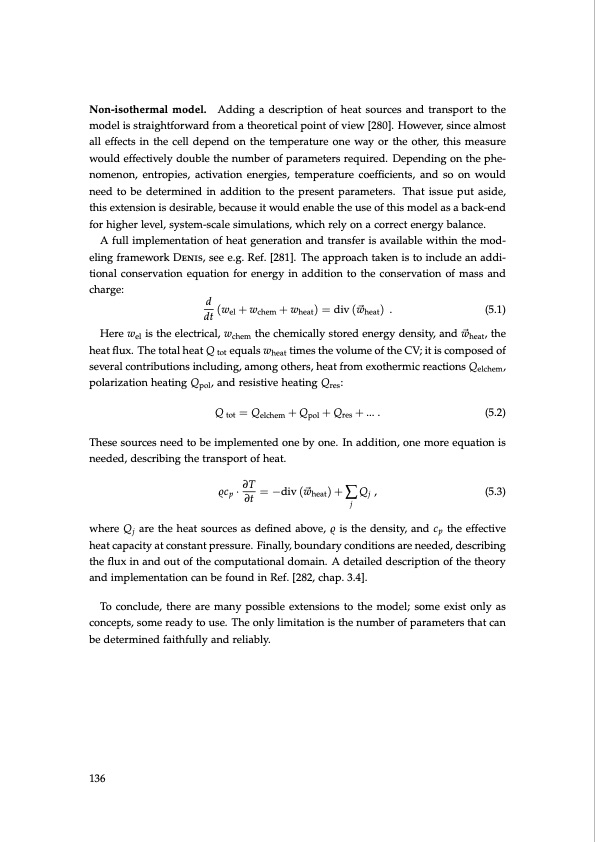
PDF Publication Title:
Text from PDF Page: 136
Non-isothermal model. Adding a description of heat sources and transport to the model is straightforward from a theoretical point of view [280]. However, since almost all effects in the cell depend on the temperature one way or the other, this measure would effectively double the number of parameters required. Depending on the phe- nomenon, entropies, activation energies, temperature coefficients, and so on would need to be determined in addition to the present parameters. That issue put aside, this extension is desirable, because it would enable the use of this model as a back-end for higher level, system-scale simulations, which rely on a correct energy balance. A full implementation of heat generation and transfer is available within the mod- eling framework Denis, see e.g. Ref. [281]. The approach taken is to include an addi- tional conservation equation for energy in addition to the conservation of mass and charge: d (wel + wchem + wheat) = div (w⃗ heat) . (5.1) dt Herewel istheelectrical,wchem thechemicallystoredenergydensity,andw⃗heat,the heat flux. The total heat Q tot equals wheat times the volume of the CV; it is composed of several contributions including, among others, heat from exothermic reactions Qelchem, polarization heating Qpol, and resistive heating Qres: Qtot = Qelchem +Qpol +Qres +... . (5.2) These sources need to be implemented one by one. In addition, one more equation is needed, describing the transport of heat. ∂T ∂t where Qj are the heat sources as defined above, ρ is the density, and cp the effective heat capacity at constant pressure. Finally, boundary conditions are needed, describing the flux in and out of the computational domain. A detailed description of the theory and implementation can be found in Ref. [282, chap. 3.4]. To conclude, there are many possible extensions to the model; some exist only as concepts, some ready to use. The only limitation is the number of parameters that can be determined faithfully and reliably. 136 ρcp· =−div(w⃗heat)+∑Qj , (5.3) jPDF Image | Lithium-Sulfur Battery: Design, Characterization, and Physically-based Modeling

PDF Search Title:
Lithium-Sulfur Battery: Design, Characterization, and Physically-based ModelingOriginal File Name Searched:
Dissertation_David_N._Fronczek_The_Lithium_Sulfur_Battery.pdfDIY PDF Search: Google It | Yahoo | Bing
Sulfur Deposition on Carbon Nanofibers using Supercritical CO2 Sulfur Deposition on Carbon Nanofibers using Supercritical CO2. Gamma sulfur also known as mother of pearl sulfur and nacreous sulfur... More Info
CO2 Organic Rankine Cycle Experimenter Platform The supercritical CO2 phase change system is both a heat pump and organic rankine cycle which can be used for those purposes and as a supercritical extractor for advanced subcritical and supercritical extraction technology. Uses include producing nanoparticles, precious metal CO2 extraction, lithium battery recycling, and other applications... More Info
| CONTACT TEL: 608-238-6001 Email: greg@infinityturbine.com | RSS | AMP |